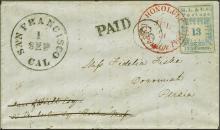Stamp Insurance - An Investment You Can Count On
Published

While insurance has been traditionally associated with fixed assets and real estate and even one’s life, keep in mind that it can also work for your stamp collection. According to industry bloggers like Carrie Van-Brunt-Wiley and Samantha Alexander, it pays to secure your stamp collection and to do it now. Philately is not just about searching and researching about valuable stamps; responsible philately also means securing your collection so that the future generations (and enthusiasts) can appreciate all these. Signing up for insurance serves as your cover in case the stamps are compromised.
Sure, you can count on albums, plastic covers and archive or museum-quality plastic sleeves, but often these are not enough in protecting the integrity of the stamps. But it’s a different thing with an insurance- it’s your complete protection against damages and even theft. But don’t just sign up for any insurance. You need to exercise due diligence when shopping for an insurance cover for your stamps.
What to look for in your policy
Here are some things you’ll need to remember when thinking about insurance coverage for stamps.
- Home insurance is different from stamp collection coverage. Clarify this with the insurance provider so you’ll know what’s covered, and if the whole value of stamps are included in the coverage;
- Learn more about the personal possessions cover that can help extend the coverage limits. There are some insurance providers that can extend coverage even outside your home, say you have lost your collection while travelling;
- It’s a good investment to sign up for the ‘all risk’ insurance policy that can completely cover your collection. You may need to pay a premium for this service, but the coverage is something you would want;
- Before you sign up for coverage, make sure that your stamp collection has been appraised and use the appraisal papers as documentation. And while completing the assessment, it would be best to take into account the contents of your stamp collection. List all your stamps, date of acquisition and value at time of acquisition;
- It is also your responsibility to inform the provider if your stamp collection is stored in a waterproof and fireproof safe. This arrangement will help lower your premiums;
- And just like your regular home policy, you need to exercise due diligence before you sign up. There are competing insurance providers out there, and you may want to spot the provider that offer the best coverage, at the lowest premium. Make sure to revisit the contract on a regular basis so that you can get a complete and appropriate coverage every time.
Make an effort to protect your stamp collection by signing up for an insurance coverage. Your stamp collection is an investment in itself that can grow, and you’ll need a professional to help you grow it.








